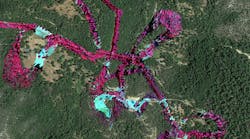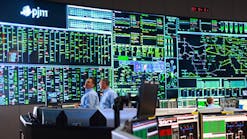Energy transition has taken on a new meaning in the light of recent geopolitical and environmental realities; and many pre-held assumptions have been turned on their head by the wildfires and bad-actor events in recent years.
Europe has experienced wildfires at a frequency and severity that is above the 15-year average, and North America similarly battles blazes. There is significant concern for loss of life and property, loss of nature, and the impacts on human health. Old certainties can no longer be relied on.
With political, economic and public pressure piling up, utilities around the world need to find ways to fundamentally alter established business models and introduce new techniques, technologies and infrastructure design to grid systems that are already feeling the strain.
Digital technology and implementing tools such as digital twins, with the capability to link a physical system with its virtual equivalent, can help companies respond to the current pressures, and whatever comes next.
The International Energy Agency (IEA) stressed the importance of digital solutions writing in its updated 2022 Electricity Markets report, ”Digitalisation is crucial for executing clean energy transitions at the speed and scale needed to meet short-term emergency needs and long-term net zero goals.”
So how can utilities make this happen?
The power of digital technology comes, primarily, from the extraordinarily diverse forms of data that are exceptionally granular and immediately actionable. With the right data, each utility can address the specific challenge it faces, whether that’s efficiency, resilience, control, balancing or a unique combination of all the above.
That, in brief, is the theory, and what many transmission and distribution (T&D) utilities have been trying to implement.
Digital First
An electric distribution system operator in Germany, with an ever-evolving renewable network, took a digital-first approach for monitoring, inspecting, and maintaining its 62,000 miles of powerlines. Field operations utilized aerial inspection techniques and an advanced software platform to gather and analyse data. Drones equipped with high-definition (HD) cameras generated photography and information about a given pole or tower, with greater speed and accuracy than can be achieved by human or manual inspection in a bucket or climbing a ladder. The operator found its powerline inspection regime was revolutionized, with the lives of employees made easier, and processes safer and more efficient.
But this is a world in which point solutions proliferate. Siloed tactics, like investing in a data-driven solution for a specific area of the business, easily swamp strategy. Overall objectives get lost in repeat data-collection exercises and overlapping functionality. Opportunities for better synergy are missed. New information silos have built up – and the dream of developing utilities fit for the current and future moment falls between the gaps.
Instead, what utilities really need is a digitalized management system that provides a complete view of the entire operation, without losing any of the depth or precision that an individual solution can provide.
Well-constructed Digital Twins
The foundation of such a system is the digital twin: a real-time digital counterpart of a utility’s real-world infrastructure.
A real – or living - digital twin is much more than a static 3D model of some adjacent assets. It represents those assets, connecting infrastructure, immediate surroundings, and inner workings in as much detail as possible; and, crucially, they incorporate the fourth dimension: time. A well-constructed digital twin that can be updated in near real time is a living counterpart to the real thing.
There are immediate advantages in terms of targeting maintenance or reducing the time, resources and risks associated with on-site inspections. Data-tagged assets, analytics and AI algorithms work together to suggest interventions that are automatically flagged to the human user. As new data is collected and contextualised over time, it becomes even more effective and more accurate.
However, current market conditions on T&D assets, such as growing demand for electricity, increased capacity pressures presented by integrating renewables, and growing challenges faced by extreme weather, such as wildfires, are helping to emphasise the value of digital twins in another area. This section specifically focuses on the power digital twins give utilities to respond to changing events with the required urgency, without compromising accuracy or effectiveness.
What-if and Emergency Management
Digital twins can accurately model ‘what if’ scenarios to gauge the actual effects of proposed actions. With vegetation management, for example, a digital twin will show not only the grid assets, but also display tree and other vegetation data, including species, growth rate, and tree health. A report is generated which prioritises risk of encroachment to networks, enabling utilities to assess their plans for remediation before they take action and dispatch vegetation management crews.
Ultimately, they can calculate the viability of their proposals, or develop alternative plans to deliver preferred outcomes. Digital modelling vastly improves decision-making, and significantly reduces the chances of being blindsided by unforeseen complications. That is going to become a far more common experience as the energy transition accelerates, climate change impacts become more apparent, and type and nature of ‘what if’ scenarios expand.
Increasing the percentage of intermittent and non-dispatchable supply from renewables in the energy mix, will have complex consequences for grid operation and management, particularly as more attention will fall on the condition of current physical assets. A developer that wants to connect a major onshore wind farm, for example, needs to understand what effect it might have on other grid assets, and whether they will need upgrading or reinforcement to cope with the increased supply. A seasoned engineer can offer an informed prediction on possible outcomes, assuming they are familiar with the assets, its age and its condition. However, with a digital twin, they can simply model the scenario and find out categorically whether the available assets are capable of handling new supply – without leaving their office.
As the ecosystem of interconnected assets and distributed resources in which they operate continues to expand and multiply, utilities will face more and more of these kinds of challenges. There will be more connection requests from industrial solar parks and domestic heat pumps, or from EV charging infrastructure and storage plants. With further connection requests comes the need for additional infrastructure, which will subsequently also rely on high-quality maintenance.
A Data Circle
The digital twin is becoming the unarguable tool to keep up with the pace of change. As a repository for collecting and indexing all network data, images, reports, analyses, and 3D point-clouds, it also expands the data that can be incorporated. A digital twin makes the case for extending data provision from current sources into new, previously unexplored areas. Aerial powerline inspection data gathered by drone and by helicopter using LiDAR, hyperspectral and HD RGB imagery is just one example of what can now be deployed. Even third-party data sources – for example satellite data for up-to-date status checks on powerlines, fault-event history, and meteorological data – can augment current capabilities and enable a leaner, more responsive operation.
Inevitably, utilities will need to continue to respond to catastrophic weather events and natural disasters. In these cases, the intricate, detailed understanding of the grid, its connected assets, and their immediate surroundings provided by a digital twin creates order in the midst of chaos, aiding emergency services and asset operators in the development of a fully informed, risk-managed response. On a more positive note, as AI algorithms ultimately learn to predict and prevent blackouts, the grid will become more resilient from each hazard or fault. Proactive measures are crucial as the power landscape, and the broader global context, continues to shift and present uncertainties to utilities.
Petri Rauhakallio is VP, Customer Operations at Sharper Shape, headquartered in Helsinki, Finland. Petri, an experienced IT and startup professional, has worked in various management positions and has a proven track record in R&D, project and product management, business development, sales and marketing. Petri has previously worked in companies including Walkbase Ltd., Teclo Networks AG, Tema Networks Ltd., Synapse Mobile Networks Ltd, Navicore Ltd., Locus Portal Corp. Petri holds a M.Sc. in Surveying and he has also studied creative methods in team management and coached in management personal development training courses.


